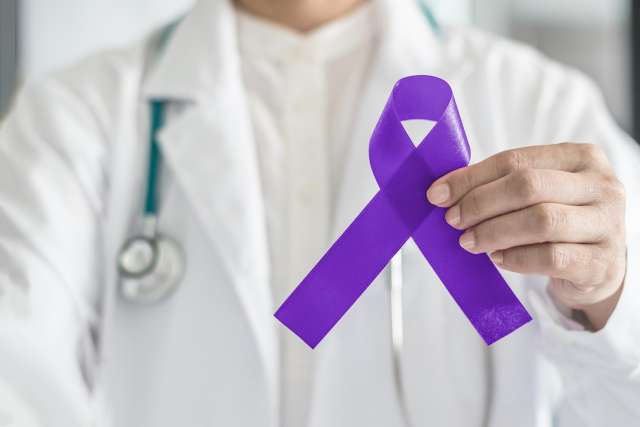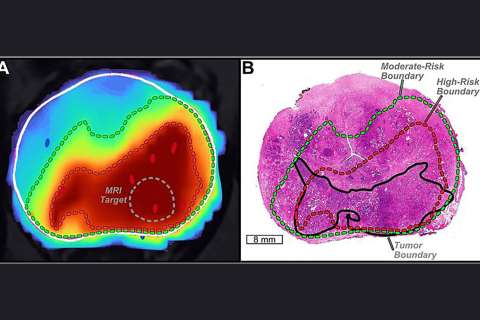Testicular cancer is the most common cancer in 15- to 34-year-olds assigned male at birth (AMAB). And cases in the United States have been increasing in recent decades — you may even notice more people wearing the purple ribbon associated with testicular cancer awareness.
Testicular cancer is typically curable, especially when found early — before it grows too large or spreads to other areas. Health care providers often check their patients’ testicles during routine check-ups. But there are no established recommendations for testicular cancer screening.
The good news is that conducting a regular self-exam of your testicles can help you identify signs of testicular cancer when they first appear. It’s an easy practice that can provide peace of mind and protect your health.
Why it’s important to screen yourself for testicular cancer
Testicular cancer can go unnoticed until symptoms arise, such as:
- Heaviness or aching in the lower stomach or testicles
- Swelling or a lump in the testicles
- Voice changes or facial and body hair growth in younger boys who haven’t gone through puberty yet
The problem is that the most common symptoms — a testicular lump or swelling — are easy to miss if you aren’t checking for them. Lumps and swelling associated with testicular cancer are rarely painful, and the mass may be as tiny as a pea.
Regularly examining your testicles is especially critical if you are at higher risk for testicular cancer because of:
- Family history of testicular cancer
- Previous testicular cancer
- Undescended testicle (cryptorchidism)
How to perform a testicular self-exam
Experts recommend examining your testicles monthly, from age 15 until 40. The best time to do it is during or immediately following a bath or shower when the skin of your scrotum (the sac that holds your testicles) is relaxed. The self-exam should only take a few minutes and should include these steps:
- Visually inspect each testicle: Hold your penis out of the way and look for any change in the size or shape of your testicles.
- Locate the epididymis and vas deferens: These soft tube-like structures on the back of your testicles collect and carry sperm. Get familiar with them so you don’t mistake them for lumps.
- Examine each testicle individually: One at a time, gently roll each testicle between your thumb and fingers. The goal is to feel the entire surface of each testicle to check for any hard lumps, nodules (smooth masses) or inconsistencies in the firmness.
What’s normal for testicles
Testicles differ from person to person and even within the pair. Knowing what’s considered normal can help when checking for something abnormal. It’s normal for each person’s testicles to vary in:
- Size: In full-grown adults, testicles are typically slightly smaller than a golf ball, but one may be slightly larger.
- Position: One testicle often hangs lower than the other.
In addition to the soft tubes attached to the back of your testicles, blood vessels and tissue may feel bumpy the first time you examine yourself. Once you perform self-exams regularly, you’ll establish what’s normal for your body. If, at any time, you aren’t sure if what you see or feel is normal, ask your provider to check it out.
If you have swelling or a lump in your scrotum …
A lump or swelling does not always mean you have testicular cancer. It’s not typically easy to tell if the lump or swelling you find is located on your testicle or if it’s caused by another issue within your scrotum. That’s why it’s critical to have a health care provider assess any abnormality you detect.
If the lump is on your testicle, there’s a 75% risk of it being testicular cancer. But only 4% of people with scrotal lumps or pain are diagnosed with testicular cancer. The lump or swelling you feel could be symptomatic of another condition that affects your testicles, such as:
- Epididymal cysts: These small fluid-filled lumps typically form in the soft tube behind the testicle.
- Epididymitis: Swelling of the epididymis can be treated with antibiotics.
- Hydrocele: This collection of fluid around the testicle is not dangerous but can be surgically removed if it becomes uncomfortable.
- Testicular torsion: Surgery is usually required to fix this twisting of the testicles.
- Varicocele: The veins around the testicle can enlarge, causing them to feel lumpy.
Your physician will perform a physical examination. They may also order an ultrasound to diagnose the condition properly. No lump, swelling or pain in the scrotum or testicles is ever normal — it’s always best to consult with a medical professional when you have concerns.



